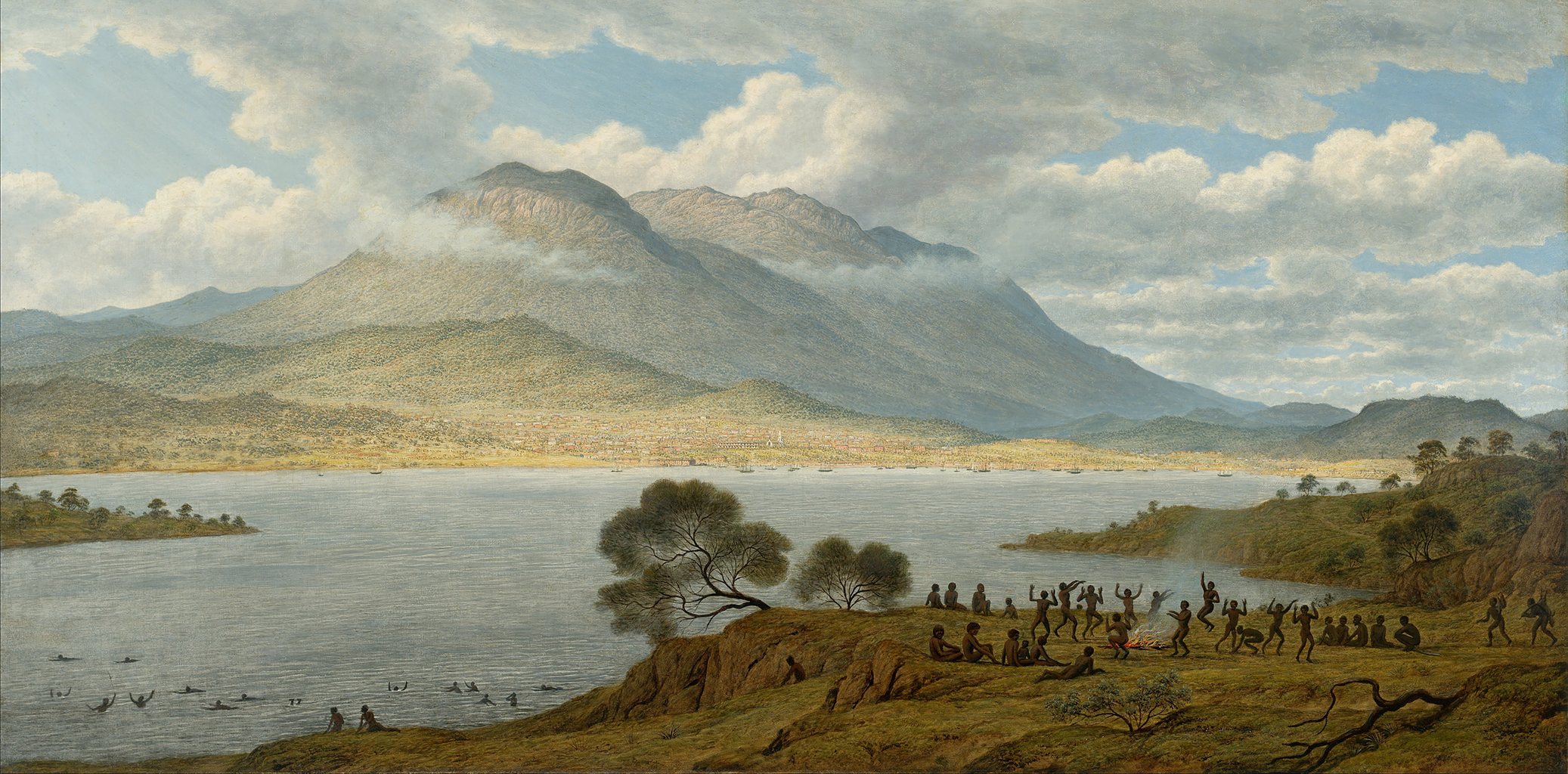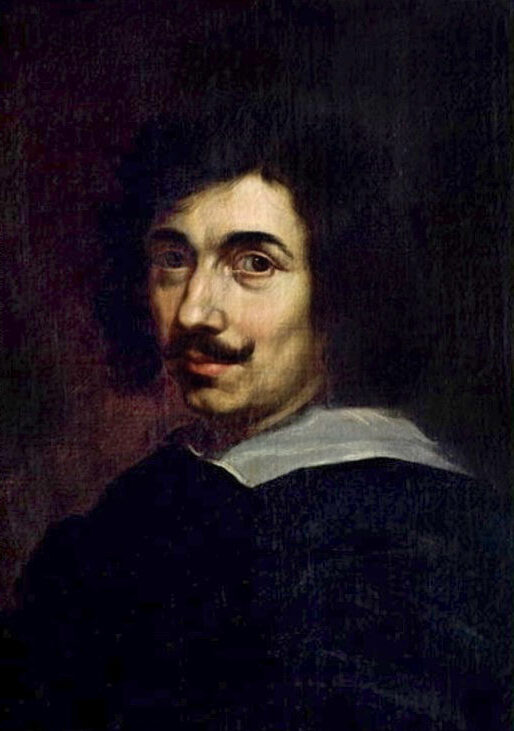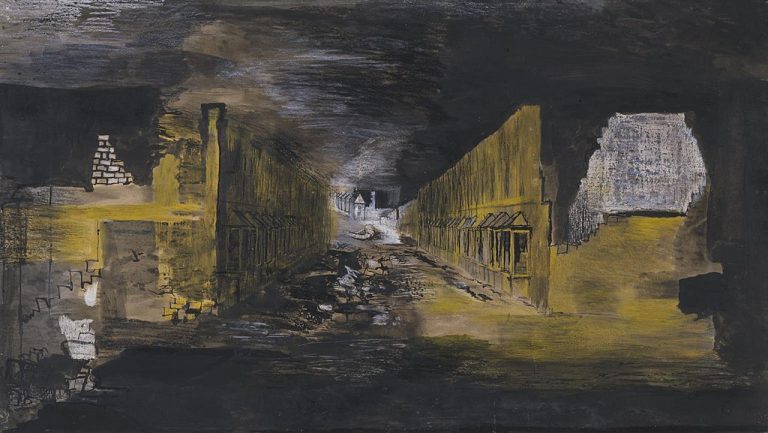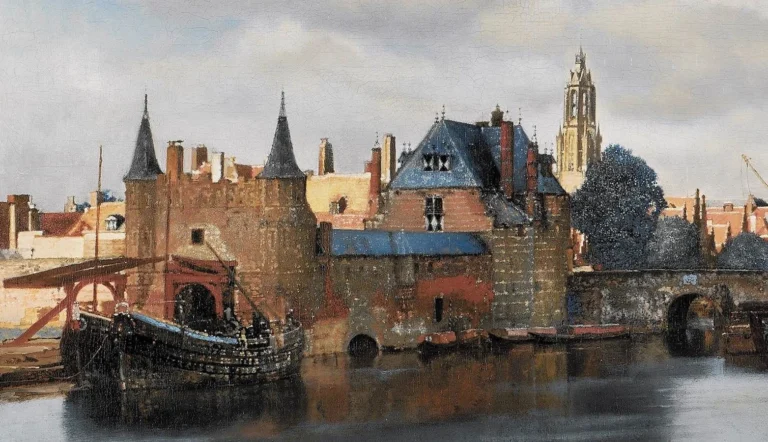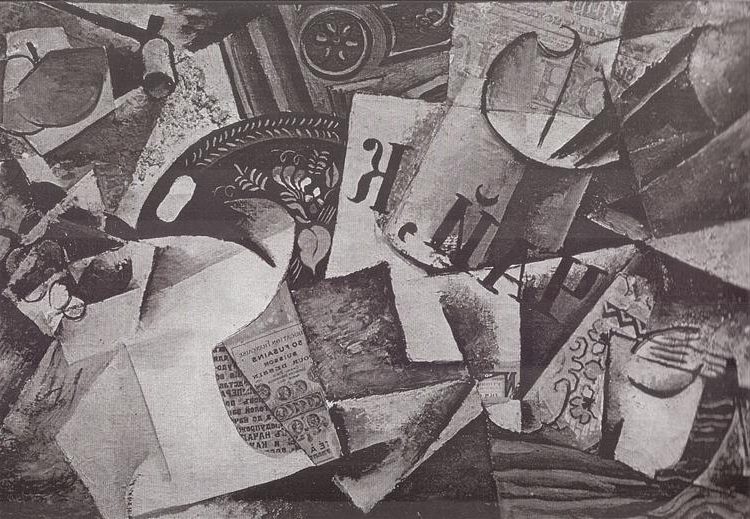Claude Lorrain Painter: Master of Baroque Landscape Art in 17th Century Europe
Born: 1600 or 1604/5, Chamagne, Duchy of Lorraine
Death: 21 November or 23 November 1682, Rome, Papal States
Art Movement: Baroque
Nationality: French
Teachers: Agostino Tassi, Goffredo Wals, and Claude Deruet
Claude Lorrain Painter: Master of Baroque Landscape Art in 17th Century Europe
Life and Career of Claude Lorrain
Claude Lorrain emerged as one of the most influential landscape painters of the Baroque period. His career spanned several decades in Rome. There, he developed his distinctive style of idealized landscapes that captured atmospheric light effects with remarkable skill.
Early Years in France
Claude Lorrain was born Claude Gellée in 1604 or 1605 in the Duchy of Lorraine, which was then part of the Holy Roman Empire. His humble origins as the son of a pastry cook contrasted with his future artistic success.

Landscape with a Piping Shepherd, c. 1629–1632 by Claude Lorrain
Orphaned by age twelve, Claude moved to Freiburg to live with his older brother, who worked as a wood carver. This early exposure to artistic craftsmanship likely influenced his future path.
Claude received little formal education, which may explain why he remained barely literate throughout his life. His artistic training began in Naples, where he worked as a domestic servant for a landscape painter who taught him basic techniques.
Development in Italy
Claude settled in Rome around 1627, where his career truly flourished. He studied under Italian landscape painter Agostino Tassi, developing technical skills and artistic vision during this formative period.
By the early 1630s, Claude had established himself as an independent artist. He joined the prestigious Accademia di San Luca in 1633, marking his official acceptance into Rome’s artistic community.
His earliest dated canvas from 1629 shows he was already developing his distinctive approach to landscape painting. Claude’s work featured carefully structured compositions with classical ruins, harbors, and pastoral scenes bathed in golden light.
He kept meticulous records of his paintings in a notebook called the “Liber Veritatis” to prevent forgeries of his increasingly valuable work.
Influence and Patrons
By 1638, Claude’s reputation had grown substantially, attracting prestigious patrons including Pope Urban VIII. His client list expanded to include European aristocracy and wealthy merchants who sought his idealized landscapes.

Noli Me Tangere, 1681 by Claude Lorrain
Claude’s paintings became highly prized for their harmonious composition and luminous quality. His distinctive ability to render atmospheric light effects, particularly sunrises and sunsets, set his work apart from his contemporaries.
Despite his success, Claude maintained a modest lifestyle and a dedicated work ethic. He rarely left Rome after establishing himself there, preferring to focus on perfecting his artistic vision.
His influence extended far beyond his lifetime, inspiring generations of landscape painters. The “Claude glass,” a tinted convex mirror used by artists and tourists to view landscapes in a Claudean manner, demonstrates his lasting impact on how people perceived natural beauty.
Artistic Style and Techniques
Claude Lorrain developed a distinctive artistic approach that combined meticulous observation with idealized beauty. His techniques established new standards for landscape painting that influenced artists for centuries.
Landscape Painting
Lorrain revolutionized landscape painting by elevating it from background scenery to the main subject. He worked directly from nature, making detailed outdoor sketches that captured authentic natural elements. This practice was unusual for his time but became foundational to later landscape traditions.

Landscape with the Adoration of the Golden Calf, 1653, by Claude Lorrain
Unlike his contemporaries, Lorrain carefully structured his compositions with framing elements like trees and architectural features that guided the viewer’s eye. He typically arranged his landscapes in receding planes that created a sense of depth.
Lorrain’s paintings feature harmonious proportions and balanced elements. He often included small human figures engaged in mythological or biblical narratives, but these remained secondary to the landscape itself.
Light and Atmosphere
Lorrain mastered the portrayal of light, earning him the nickname “master of golden light.” His paintings capture subtle atmospheric effects through careful gradations of tone and color.
He excelled at depicting different times of day, particularly dawn and dusk. His signature golden sunlight filters through trees, reflects on water, and bathes landscapes in warm, luminous glows.
Technical innovations include his handling of aerial perspective, where distant objects appear lighter and less distinct than closer ones. This technique creates a convincing sense of atmosphere and space.
Lorrain achieved these effects through glazing techniques—applying multiple thin, transparent layers of paint to create luminosity and depth that no single application could achieve.
Classical Ideal
Lorrain’s work embodies “idealized realism”—landscapes based on real observations but perfected to represent an idealized classical world. He transformed the Italian countryside into scenes of harmonious beauty.
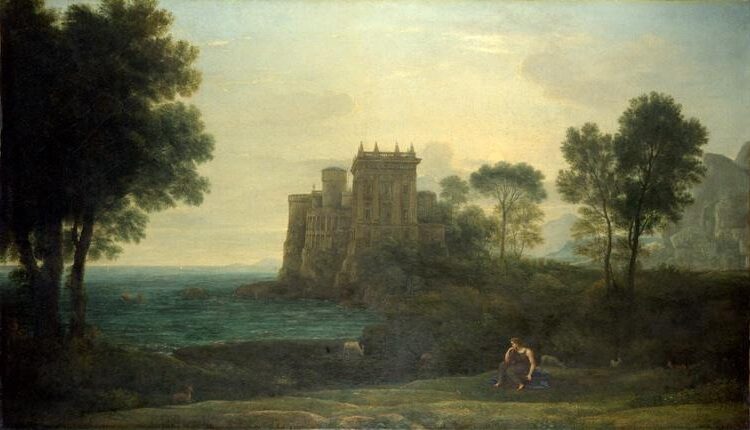
Landscape with Psyche Outside the Palace of Cupid (The Enchanted Castle), 1664
His compositions frequently include classical architecture and ruins alongside carefully placed trees and waterways. These elements create a sense of timeless perfection rather than depicting specific locations.
Lorrain’s landscapes evoke the mythic Golden Age—a peaceful, orderly world where humans live in harmony with nature. This approach aligned with Baroque classical ideals of beauty and proportion.
His influence extended beyond painting to landscape design, as wealthy estate owners sought to recreate his pictorial compositions in their gardens and grounds.
Legacy and Notable Works
Claude Lorrain created a lasting artistic legacy through his masterful landscape paintings that influenced generations of artists. His distinctive style captured idealized scenes with perfect balance of light, architecture, and nature.
Collection of Etchings: ‘Liber Veritatis’
The Liber Veritatis (Book of Truth) stands as one of Claude Lorrain’s most significant contributions to art history. This album contained drawings of nearly all his paintings, created between 1635 and 1682. Claude began the collection to prevent forgeries of his work, which had become a serious problem due to his popularity.
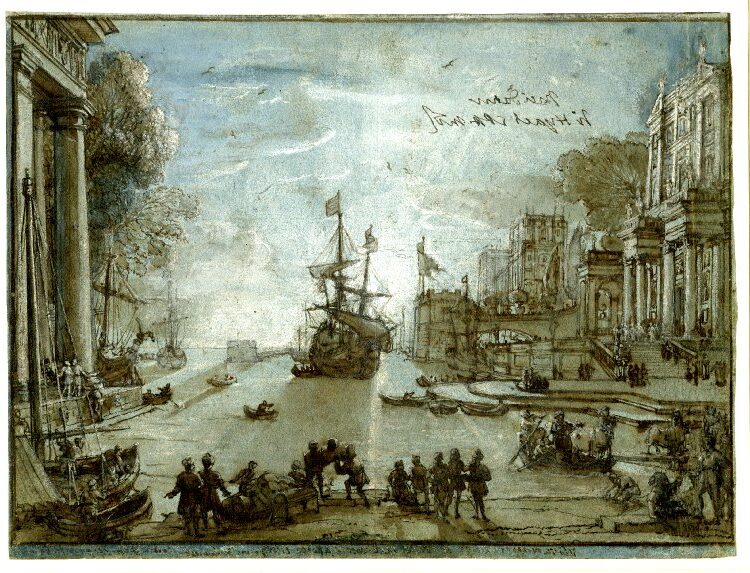
Liber Veritatis record of Seaport with Ulysses returning Chryseis to her father (from Homer), 1650
Each drawing included details about the painting’s commissioner and date on the back. The Liber Veritatis eventually contained 195 drawings, providing a comprehensive catalog of his artistic output.
Today, the British Museum houses this remarkable collection. Art historians consider it an invaluable resource for understanding Claude’s artistic development and working methods.
Famous Paintings
Claude’s most celebrated works showcase his mastery of atmospheric light effects and harmonious compositions. “Harbor Scene at Sunset” (1643) demonstrates his ability to capture the golden glow of dusk reflecting on water.
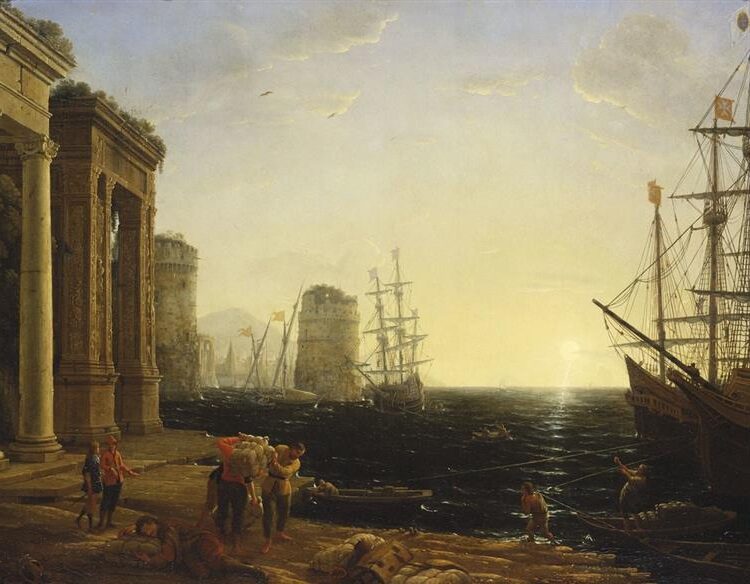
Harbour Scene at Sunset, 1643 by Claude Lorrain
“Landscape with the Marriage of Isaac and Rebecca” (1648) exemplifies his ideal pastoral scenes with classical architecture. This painting balances natural elements with human figures in perfect harmony.
“The Embarkation of the Queen of Sheba” (1648) stands among his masterpieces, featuring a magnificent harbor scene bathed in morning light. The composition’s perfect symmetry and light effects influenced countless artists.
His “Coast View with Apollo and the Cumaean Sibyl” (1646) showcases his skill at integrating mythological narratives within stunning landscapes.
Impact on Future Generations
Claude’s influence extended far beyond his lifetime, shaping landscape painting for centuries. English artists like J.M.W. Turner and John Constable studied his techniques extensively, particularly his handling of atmospheric light.
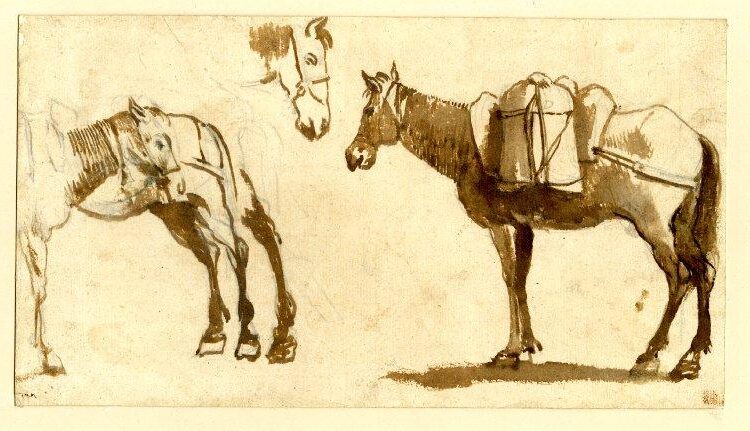
Drawing of Mules, Including One Full Length, 1630–1640 by Claude Lorrain
The “Claude glass” – a slightly convex, tinted mirror – became popular among tourists and artists in the 18th century. Users would turn their backs to a landscape and view it in the glass, which transformed the scene to resemble Claude’s paintings.
His work influenced not only painting but also landscape garden design in England. “Claudean landscapes” with carefully arranged trees, water features, and classical structures became fashionable at estates throughout Britain.
Even today, photographers and filmmakers often reference “Claudean light” when describing the golden atmospheric glow of sunset scenes.
Frequently Asked Questions
Claude Lorrain mastered techniques of light, perspective, and composition that defined Baroque landscape painting. His works contain distinctive features that art enthusiasts frequently inquire about, from his technical methods to his lasting influence.
What artistic techniques are most characteristic of Claude Lorrain’s style?
Claude Lorrain’s most distinctive technique was his masterful use of light. He often depicted sunrise or sunset scenes with golden atmospheric effects that created depth and mood.
His compositions typically followed a three-part structure with framing elements on the sides and a receding middle ground leading to a luminous horizon. This created a sense of depth and drew viewers into his landscapes.
Claude also used the technique of repoussoir, placing dark elements in the foreground to enhance the impression of distance. His later works show increasingly careful execution with meticulous attention to detail.
Which notable works by Claude Lorrain are displayed in the National Gallery?
The National Gallery in London houses several significant works by Claude Lorrain. “Seaport with the Embarkation of the Queen of Sheba” (1648) demonstrates his mastery of classical harbor scenes bathed in golden light.
“Landscape with Narcissus and Echo” (1644) showcases his mythological themes within an idyllic landscape setting. “The Marriage of Isaac and Rebecca” (1648) is another notable work displaying his skill at harmonizing figures within a grand landscape.
“A View of the Campagna from Tivoli” shows Claude’s ability to capture atmospheric effects and the distinctive Italian landscape that influenced his artistic vision.
How has Claude Lorrain influenced the development of landscape painting?
Claude Lorrain elevated landscape painting from a background element to a respected artistic genre. His work established the classical landscape tradition that influenced generations of painters across Europe.
His balanced compositions and treatment of light directly influenced 18th and 19th-century landscape artists like J.M.W. Turner and John Constable. Turner particularly admired Claude’s atmospheric effects and light handling.
Claude’s “Liber Veritatis,” a record book of his compositions, became a valuable reference for later artists. His idealized approach to nature shaped the Picturesque and Romantic movements in European art.
Can you describe the typical themes found in Claude Lorrain’s Pastoral Landscapes?
Claude’s pastoral landscapes often feature mythological or biblical narratives set in idealized countryside settings. These scenes typically include shepherds, travelers, or classical figures engaged in peaceful activities.
Water features prominently in many works, with rivers, harbors, or coastlines creating visual paths through the composition. Claude combined real observations of nature with classical architectural elements to create harmonious, timeless scenes.
His pastoral works frequently convey themes of the Golden Age, suggesting a perfect harmony between humans and nature in an ancient, idealized world.
What is the significance of Claude Lorrain in the history of art?
Claude Lorrain transformed landscape painting by elevating it from a background element to a respected genre in its own right. His work bridged the gap between realistic observation and idealized composition.
He developed innovative techniques for depicting atmospheric perspective and the effects of light that influenced generations of later artists. His careful balance of natural elements and classical architecture created a template for ideal landscape composition.
Claude’s influence extended beyond painting into garden design and architecture. His vision of harmonious landscapes shaped aesthetic tastes across Europe for centuries.
Are there any notable collections of Claude Lorrain’s drawings accessible to the public?
The British Museum in London holds an extensive collection of Claude’s drawings. Many are from his “Liber Veritatis,” his personal record of completed paintings. These drawings provide insight into his compositional process.
The Louvre in Paris houses numerous Claude drawings that showcase his development as an artist. These include preliminary sketches and nature studies that reveal how he constructed his idealized landscapes.
The Teylers Museum in Haarlem, Netherlands, and the Albertina in Vienna also contain significant Claude drawings. These collections demonstrate his technical skill and attention to detail in the drawing medium.

